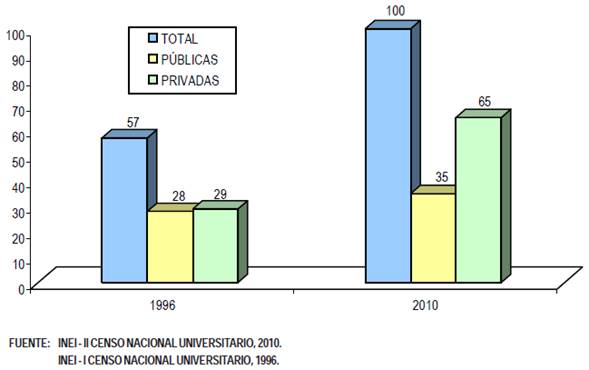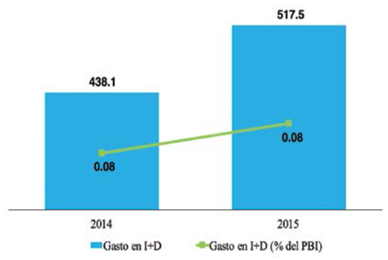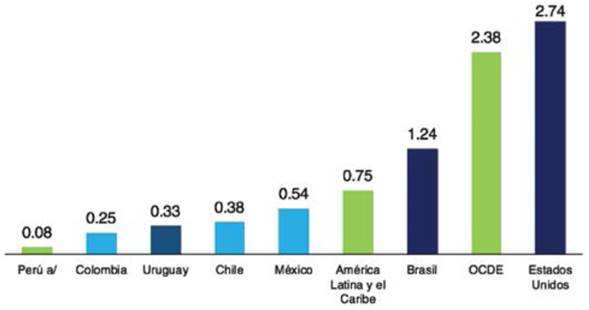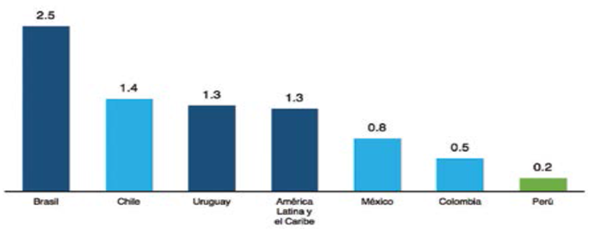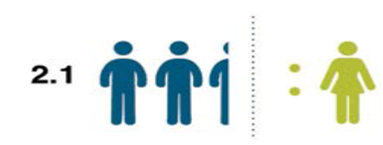Mendive. Revista de Educación
ISSN 1815-7696
02--2020
Review article
Graduates studies and scientific research in Peruvian universities
1 Universidad Nacional de Educación “Enrique Guzmán y Valle”. Perú
2 Universidad Norbert Wiener. Perú
The University has the essential function of research, in addition to continuing with the professional training of those who graduate. This research presented how was the growth of postgraduate studies and the evolution of scientific research in Peruvian universities, as well as the socialization of the results of such research in high impact journals. The study was carried out at the National University of Education "Enrique Guzmán y Valle" of Peru and had the collaboration of the rest of the Peruvian universities. The review showed that the themes of teaching and learning methods prevail, there is little impact and little visibility of the thesis and students prefer to publish their research as a book. It is sought that universities offer an optimal and quality educational service.
Keywords: Postgraduate; investigation; publication; discharge; educational quality
Introduction
At present, education manages to stimulate the competitiveness of nations by being constituted, not only as a strategy that promotes the development of knowledge and the formation of communities, but also as the means that increases the intellectual capital of society (Silas, 2012).
Postgraduate education, in the case of the third world, according to Manzo, Rivera & Rodríguez (2006), becomes, in addition to a profitable investment, a strategic instrument that directly affects development policies. Hence, it is urgent to raise awareness among all those involved (politicians, rulers, university authorities, the productive sector, among others) about the importance and social need to structure policies and systems of postgraduate studies, because these allow the creation of Scientific, technical and humanistic knowledge that society requires, based on research.
Therefore, graduate programs, specifically, in education constitute one of the most suitable spaces to contribute new knowledge in that field, in addition to fulfilling an important role in the production and socialization of knowledge among all those who participate there: teachers, academics, public policy makers, media (Chavoya & Valencia, 2013).
Hence, the present research sought to present how the development of the postgraduate courses and the evolution of the research in the universities of Peru has been, in order to have an overview of what exists and what is expected in a modern society.
The study was carried out at the National University of Education "Enrique Guzmán y Valle" of Peru and also had the collaboration of the rest of the Peruvian universities that provided access to the requested information and that was integrated with the use of level methods theoretical as: analytical - synthetic, inductive - deductive and historical - logical to perform the bibliographic analysis. The referenced documentary sources include scientific articles, internet documents and legal sources from Peru. High impact databases (Scopus, WoS and SciELO) were also consulted to know the status of scientific publications in public and private universities of the Peruvian university system.
Development
According to Barrios (2013), since 1996, the year of the first University Census, to the year 2010, the second University Census in Peru, there is a notable increase in university institutions nationwide. In 1996, 57 universities were registered in the country, almost equally public and private universities (28 public and 29 private). In 2010 there were 100 universities, with a considerable growth of private universities, which amounted to a total of 65, increasing by 1.8 times their number compared to 1996 (Figure 1). Barrios (2013).
Currently, according to the National Superintendence of Higher University Education, created on January 26, 2016, there are 143 universities, 51 public and 92 private universities in the country.
It is relevant to note that Peru is the second country that has more universities in South America. Brazil surpasses it with 197, which has a population seven times greater. The body that has been responsible for authorizing the operation requests, since 1997 has been the National Council for the Authorization and Operation of Universities (CONAFU), created in parallel to the National Assembly of Rectors (ANR).
On the other hand, public and private universities must also go through a licensing process by the National Superintendence of Higher University Education. This is to verify if the university meets the basic quality conditions (CBC) that allow it to offer an optimal educational service; In addition to monitoring whether the resources are allocated for educational purposes and quality improvement.
For licensing, CBCs are taken into account, which are minimum standards, which serve as general guidelines for the evaluation of the university's capacity, for the provision of the university higher education service and authorization of its operation. The National Superintendence of Higher University Education presents eight CBCs that every Peruvian university must meet to achieve licensure. These are:
Condition I: existence of academic objectives, degrees and degrees to be awarded, and corresponding curricula.
Condition II: educational offer compatible with the purposes proposed in the planning instruments.
Condition III: adequate infrastructure and equipment to fulfill its functions (classrooms, libraries, laboratories, among others).
Condition IV: lines of research to be developed.
Condition V: verification of the availability of qualified teaching staff with no less than 25% of full-time teachers.
Condition VI: verification of basic complementary educational services (medical, social, psycho pedagogical, sports service, among others).
Condition VII: existence of mediation and labor insertion mechanisms (job bank or others).
Condition VIII: Complementary CBC: transparency of universities.
Postgraduate studies in Peru date back to 1960, the first institution to offer this program were the National Agrarian University with the specialty of Agriculture. These studies are academic programs that are offered with the purpose of training high-level human resources, capable of applying, deepening and innovating knowledge in specific areas of science, technology and humanities. They are done after obtaining the bachelor's degree. , The degrees are bachelor, master and doctor, in that same order. To be a master you must be a bachelor and to be a doctor you must be a master. In the case of the second professional specialty, a bachelor's degree or other equivalent degree is necessary.
Postgraduates in Peru have been governed by a double regulation: on the one hand, the one established in university laws, and, on the other, in the internal norms of each university. In the latter framework, it should be noted that it is the private institutions that have the greatest autonomy to establish them. With respect to the first regulations, the last two university laws (Peru. The congress of the Republic, 1983, 2014) order that only universities can organize masters and doctoral studies.
In Law N ° 23733 (Peru. Congress of the Republic, 1983) it was pointed out that the duration of the master's and doctorate was at least 4 semesters, with the knowledge of foreign languages, for master's degree one and for the doctorate two; besides that they had to support and approve a research paper that should be original and critical (Díaz-Bazo & Sime, 2016).
For Díaz-Bazo & Sime (2016), in the University Law No. 30220 of 2014 (Peru. Congress of the Republic, 2014) there are clear differences in terms of master's and doctoral studies. For example, it is pointed out that the PhD seeks the development of knowledge at the highest level with the support of a thesis of maximum academic rigor and original character, where in addition, one of the two foreign languages can be replaced by a native language and that its duration is at least six academic semesters. When comparing the law of 1983 with that of 2014, it can be seen that there was no clarity about the purpose of doctoral studies, which has been overcome with the new one.
Based on the II National University Census (Peru. National Institute of Statistics and Informatics, 2011), it has been determined that, in Peru, there are 30 doctoral programs in education in 29 universities, of which half belong to public universities; and the other, to private universities. However, it is worth clarifying that so far there are no official data that allow us to specify the evolution of the postgraduate course, although there are others more global about its growth in the case of doctoral programs, which have been developed under questionable conditions due to the limited regulations for evaluation, approval and accreditation. This contrasts with other experiences of Latin American countries, such as Brazil, Mexico and Argentina, in which there are policies that periodically classify and evaluate these studies (Díaz-Bazo & Sime, 2016).
According to the National Institute of Statistics and Informatics of Peru (2011) in 1996 the students of public universities made up the majority (59.6% of the total), the private university, by virtue of its accelerated growth it manages to position itself in the 2010 as the one with the largest student population (60.5%). In the reference period, postgraduate students multiplied by 5.2 times, from 10,818 in 1996 to 56,358 in 2010.
The growth of the university population is significantly greater than the population growth of the country. The interannual growth rate is 6.2% for undergraduate students. Graduate population growth doubles this figure, rising to 12.4% (Peru. National Institute of Statistics and Informatics, 2011). Another interesting fact is the growth of private universities by four percentage points compared to public universities (Table 1).
Table 1 University population by census year and annual growth rate according to type of university.
| Type of university | Number of university | Students | University teachers | |
|---|---|---|---|---|
| Pre Grade | Post Degree | |||
| 2010 | ||||
| Total | 100 | 782 970 | 56 358 | 59 085 |
| Public | 35 | 309 175 | 24 591 | 21 434 |
| Private | 65 | 473 785 | 31,767 | 37 651 |
| 1996 | aaa | aaa | aaaa | aaaaa |
| Total | 57 | 335 714 | 10 818 | 25 795 |
| Public | 28 | 199 943 | 7 109 | 16 096 |
| Private | 29 | 135 771 | 3 709 | 9 699 |
| Annual growth rate. 1996-2010 period | ||||
| Total | 4.2 | 6.2 | 12.4 | 5.2 |
| Public | 1.6 | 3.1 | 9.2 | 1.4 |
| Private | 6.0 | 9.3 | 16.5 | 9.1 |
Source:Barrios (2013).
Although today's world demands a constant update from professionals to compete in better conditions in the labor market, 74.9% of university graduates have not carried out any postgraduate studies as graduates or master's degrees. According to the National Institute of Statistics and Informatics of Peru (2011), only 25.1% of professionals have followed a postgraduate course, highlighting that of this total, the majority are women who come from private universities (64.6%) and public universities (55.5 %).
Casimiro and Casimiro (2016), based on the II National University Census 2010 (Peru. National Institute of Statistics and Informatics, 2011), highlight the following data: a) there is 7% of the population in higher education, this is equivalent to 56,336 graduate students across the country; b) the majority of the student population, 50%, are located in the capital Lima, other areas have less proportion, such is the case of the sierra and jungle regions; c) the highest percentage of students is located in the masters with 92% and in the doctorates only 8%; d) postgraduate studies are self-financed in public institutions (91%); e) weekends are considered for postgraduate studies; f) the graduation rate of postgraduate studies is less than 5% of the enrollment; g) 31% of the population in higher education studies masters.
According to the II National University Census 2010 (Peru. National Institute of Statistics and Informatics, 2011), of the population of postgraduate students, women have greater representation both in the master's degree and in the II specialization with 51.4% and 60, 3%, respectively. Men, on the other hand, have a greater participation in the doctorate with 59.9% (Table 2).
Table 2 Total postgraduate students by sex, according to postgraduate studies.
| Studies of Post degree | Total | Sex | ||||
|---|---|---|---|---|---|---|
| Man | Woman | |||||
| Abs. | % | Abs. | % | Abs. | % | |
| Total | 56 358 | 100 | 27 158 | 48.2 | 29 200 | 51.8 |
| II Specialization | 7 726 | 100 | 3,069 | 39.7 | 4 657 | 60.3 |
| master's degree | 44 577 | 100 | 21 660 | 48.6 | 22 917 | 51.4 |
| Doctorate | 4,047 | 100 | 2 423 | 59.9 | 1 624 | 40.1 |
| Not specified | 8 | 100 | 6 | 75.0 | two | 25.0 |
Note: Includes all the universities that have been formally functioning in the Peruvian University System. Source: INEI-II University Census, 2010
Observing the age composition of graduate students, the highest concentration in population, both in public and private universities is in the age group of 25 to 30 years (26.8%), followed by the group of 31 to 35 years (22.3%), the 36 to 40 year old group continues (16.1%), the 41 to 45 year old group (12.4%) and the 51 to older group has a population of 9, 4 %.
The age groups between the ages of 20 and 35 make up the majority of graduate students. This aggregate shows a somewhat higher value in public universities than private ones (55, 4% and 51, 4%, respectively) (Table 3).
Table 3 Total postgraduate students by age group, according to type of university.
| Type of University | Total | Groups of ages | MEP | ||||||
|---|---|---|---|---|---|---|---|---|---|
| 20-24 years | 25-30 years | 31-35 years | 36-40 years | 41-45 years | 46-50 years | 51 or more years | |||
| Total | 56 358 | 2 291 | 15 107 | 12 577 | 9 090 | 6 960 | 4 992 | 5 324 | 17 |
| % | 100 | 4.1 | 26.8 | 22.3 | 16.1 | 12.4 | 8.9 | 9.4 | 0.0 |
| Public | 24 591 | 966 | 7 129 | 5 544 | 3 684 | 2 720 | 2 103 | 2 438 | 7 |
| % | 100 | 3.9 | 29.0 | 22.5 | 15.0 | 11.1 | 8.6 | 9.9 | 0.0 |
| Private | 31,767 | 1 325 | 7 978 | 7 033 | 5 406 | 4 240 | 2 889 | 2 886 | 10 |
| % | 100 | 4.2 | 25.1 | 22.1 | 17.0 | 13.4 | 9.1 | 9.1 | 0.0 |
Note: Includes all the universities that have been formally functioning in the Peruvian University System Source: INEI-II University Census, 2010
According to the information found from the different universities that offer postgraduate degrees in education, the highest percentage of postgraduate studies are regular basic education teachers, then teachers from public and private universities of the different universities of the Peru and a smaller percentage other professionals.
In the case of teachers of basic education, their participation in postgraduate courses becomes more active as a result of the application of the Law of the Teaching Public Career (Peru Congress of the Republic, 2007), where meritocracy is prioritized. But it was with the Magisterial Reform Law (Peru. Congress of the Republic, 2012), approved in 2012 by the Congress of the Republic, which establishes a teaching career based on merit, whose main objective is to promote the professional development of teachers, providing greater benefits and better working conditions as a key axis to improve the teaching of education in our country), it is there where the debates on salary scales and their access to them begin that sidelined the importance of training teacher training that clearly identifies the teacher's training needs that enable incentives for teachers of outstanding performance.
In the case of professionals who carry out university teaching, the new University Law 30220 (Peru. Congress of the Republic, 2014) says the following in its article 82: For the exercise of university teaching, as an ordinary and hired teacher it is mandatory to have:
The degree of Master for training at the undergraduate level.
The Master or Doctor degree for masters and specialization programs.
The degree of Doctor for training at the doctoral level.
In this way, universities with postgraduate degrees in education are those that increase the number of students in their programs. From the information found it can be evidenced that a private university has 15% of all future teachers and doctors in the country.
Research in Peruvian universities
The recognition of research in the university system is not new; the first and most significant impulse was given with the remembered Peruvian Educational Reform that appeared in 1968, with the government of General Juan Velazco Alvarado. This educational reform extends to the university level and in 1969 (50 years ago) with the Organic Law of the Peruvian University (Peru. Congress of the Republic, 1969), research is considered as a basic function of the University. It must be recognized that for these years the National Research Council was created for the first time, and then converted into the National Council of Science and Technology and later as the National Council of Science Technology and Technological Innovation (CONCYTEC). A few years later, specifically in the democratic government of Architect Fernando Balaunde, University Law No. 23733 is promulgated (Peru Congress of the Republic, 1983). There, research stands out as one of the essential purposes of the Peruvian university.
In response to the impulse that should be given to research, it was from 2006 when universities began to organize and create the Vice-Rectorate for Research, one of them was the National University of San Marcos (UNMSM). Then, in 2009, the Pontifical Catholic University of Peru (PUCP) created its vice-rector's office.
Then, in 2014, University Law No. 30220 (Peru. Congress of the Republic, 2014) is presented, which also presents research as a basic function of the University, highlighting the creation or adaptation of organs and dependencies to central level and at the level of graduate school and professionals and faculties. It was with this law that a large part of Peruvian universities have been concerned with the creation of the vice-rector's office as a way of organizing and systematizing research.
Currently, the Consejo Nacional de Ciencia Tecnología e Innovación Tecnológica en Perú (2016, 2017), has been promoting the participation of companies in scientific, technological and innovation research, as a way in which not only they obtain tax benefits but also to contribute to the development of research in the country (Peru Congress of the Republic, 2018).
The effort of the National Council of Science Technology and Technological Innovation (2019a b) is commendable, to accredit researchers in our country by creating two important databases, one is the National Directory of Researchers and Innovators and the Registry of Researchers in Science and Technology of the National System of Science Technology and Technological Innovation. The resume of the Peruvian professionals who carry out activities related to science, technology and innovation is registered in the National Directory of Researchers and Innovators. In the Registry of Researchers in Science and Technology of the National System of Science Technology and Technological Innovation that part of the National Directory of Researchers and Innovators the qualification of the professionals is carried out.
Currently, they are registered and qualified by the National Council of Science Technology and Technological Innovation in Peru (2019a b), one thousand five hundred (1500) Peruvian researchers. The figure falls short when compared to other countries in the region, such as Chile, which has 20,000 qualified researchers.
According to the first National Census of Research and Development to Research Centers 2016 (Peru, National Council of Science Technology and Technological Innovation, 2017), in 2014 the R&D Research Centers spent 438 million in soles, which represented 0.08% of GDP. In 2015, there was an increase to 518 million soles. But it did not affect the percentage of GDP since it remained the same (Figure 2).
Internationally, the figure of 518 million soles is low when compared to the rest of the members of the Pacific Alliance. If compared to the Latin American average, which represents 0.75% of GDP, the difference is more marked by including data from the average of countries of the Organization for Economic Cooperation and Development or the United States, which exceed 2% of expenses.
To achieve financing, it must be demonstrated that there are capacities and qualities that allow us to reach the minimum standards. According to Marticorena (2016), in 2011 Peru was in the penultimate place in Latin America in terms of investment in research and development, a situation that has not changed much so far (Figure 3).
Figure 4 shows that Peru is at a disadvantage with other countries in the region with regard to the number of researchers, since for every thousand members of the population considered economically active (PEA) only 0.2 are researchers, 1.3 of the average of the countries of the Organization for Economic Cooperation and Development (Figure 4).
For 2015 of the total number of researchers, 68.1 % were male and 31.9 % female. When comparing these percentages with what happens in other countries of the region, it is observed that the percentage of participation of women is higher, for example, Argentina 51.5%, Venezuela 55.0%, and Colombia 37.5% (Figure 5).
When performing the analysis by age range, it is observed that 52% of the researchers were in the range of 40 to 59 years of age, while researchers under the age of 39 represent 27% of the total. Which shows that the average age of the researchers was 49 years regarding the distribution by age groups according to the sex of the researchers, the concentration in the age groups between 40 and 59 years is observed In the case of age groups under 39, the highest proportion was in women with 32.3%, unlike men, which was 24.5% (Table 4).
Table 4 Age group of researchers 2014-2015.
| Age | 2014 | 2015 | ||
|---|---|---|---|---|
| Researchers | % | Researchers | % | |
| Less than 29 | 144 | 4.7 | 233 | 6.9 |
| 30 to 39 years old | 608 | 20.1 | 678 | 20.1 |
| 40 to 49 years | 731 | 24.1 | 789 | 23.4 |
| 50 to 59 years | 912 | 30.1 | 953 | 28.3 |
| 60 to 69 years | 522 | 17.2 | 611 | 18.1 |
| 70 or more years | 115 | 3.8 | 108 | 3.2 |
| Total | 3,032 | 100 | 3 372 | 100 |
Finally, it is important to note that in the last 20 years scientific production in Peru has grown proportionally, making it multiply by eight during that time.
If you analyze the SCImago Journal & Country Rank tool, prepared by the SCImago Group, of the Higher Council for Scientific Research (CSIC) of Spain, you can know two rankings: for journals and countries, for scientific journals indexed by Scopus (SCImago Lab., 2019).
A study of the Latin American ranking in the period 1996-2018 allows us to understand that the countries with the highest scientific production are: Brazil, Mexico, Argentina, Chile, Colombia, Venezuela, Cuba and Peru. The latter country has nine (9) journals indexed in Scopus, ranks 73rd worldwide; and has one in the second quartile, two in the third and four in the fourth.
Publication in high impact journals of Peruvian universities
When conducting an exploration in the public and private universities of our university system regarding its publication of articles in journals indexed in high impact databases (Scopus, WoS or SciELO) the following was found:
Of the 143 Peruvian universities, according to data from the National Superintendence of Higher University Education, only 14 publish 29 quality indexed journals, which represents a minimal portion.
Of the 29 quality indexed journals, 21 are from private universities and 8 from public universities.
Of the 14 universities that publish quality indexed journals, 10 are in Lima and 4 in other regions. Among them are: Pontifical Catholic University of Peru (PUCP) with 9 journals, National University of San Marcos (UNMSM) with 4, Cayetano Heredia Peruvian University (UPCH) with 3, National University of the Peruvian Amazon (UNAP) and University of San Martin de Porres (USMP) with 2 each.
Of the 29 quality indexed journals the largest number is in the social sciences and humanities with 13, then the biomedical sciences with 8, the basic sciences 7, the business sciences 1.
Conclusions
In the last 20 years the creation of Peruvian universities has grown rapidly, as well as postgraduate programs, which have been developed under questionable conditions, very distant from the quality policies of other countries in the region. From 57 universities in 1996 to 143 universities in 2017, the number of private universities almost doubles the number of public universities.
The doctoral programs in education are insufficient and it is the private universities that have the largest number of students in the postgraduate course.
Postgraduate studies have suffered variations in terms of duration, which is based on the basic quality conditions for granting licensing, both undergraduate and postgraduate.
On the other hand, in terms of research, the results reveal that postgraduate theses in education respond to a more professional orientation than scientific research, which has resulted in the non-socialization of the research results prior to the writing of the thesis, situation that detracts from the field of education a valuable potential to feed research and professional practices, in addition they do not allow a better positioning in the rankings of publications in the country.
Referencias bibliográficas
Barrios, F. (2013). Análisis de las megatendencias de educación superior. Apuntes en Ciencias Sociales, 3(2), 185-196. Recuperado de https://dialnet.unirioja.es/descarga/articulo/5043002.pdf [ Links ]
Casimiro, W. H., & Casimiro, C. N. (2016). Formación de los estudios de la escuela de posgrado de la Universidad Nacional de Educación: un diagnóstico situacional. En, F., M. Vergara y G., R., Calderón (Coords.). Procesos de formación y asesoría en programas de posgrado en educación en Latinoamérica. (pp. 425-437). Lima: Pontificia Universidad Católica del Perú. [ Links ]
Chavoya, M., Valencia, A. (2013). Producción del conocimiento a través de las tesis doctorales. Estudio de algunas tesis de la generación 2004-2008 del doctorado en educación de la Universidad de Guadalajara. En, M. G., Moreno, & M., Valadez, (Coords.), Miradas analíticas sobre la educación superior . (pp. 473-496). Guadalajara: Universidad de Guadalajara. [ Links ]
Díaz-Bazo, C., & Sime Popa, L. (2016). Las tesis de doctorado en educación en el Perú: Un perfil de la producción académica en el campo educativo. Revista Peruana de Investigación Educativa, 8, 5-39. [ Links ]
Manzo, L., Rivera, N., & Rodríguez, A. (2006). La educación de posgrado y su repercusión en la formación del profesional iberoamericano. Educación Médica Superior, 20(3), Recuperado de http://scielo.sld.cu/scielo.php?script=sci_arttext&pid=S0864-21412006000300009 [ Links ]
Marticorena, B. (2016). Los desafíos de la investigación en el Perú. Recuperado de https://puntoedu.pucp.edu.pe/noticias/los-desafios-de-la-investigacion-en-el-peru/ [ Links ]
Perú. Congreso de la República. (1969). Ley Orgánica de la Universidad Peruana No. 17437 (1969). Recuperado de http://www.ulpiano.org.ve/revistas/bases/artic/texto/RDUCV/43/rucv_1969_43_207-239.pdf [ Links ]
Perú. Congreso de la República. (1983). Ley Universitaria N° 23733. Recuperado de http://www.une.edu.pe/transparencia/informacion/LeyUniversitaria_actualizada020508.pdf [ Links ]
Perú. Congreso de la República. (2007). Ley de Carrera Pública Magisterial, Ley N° 29062. Recuperado de http://www.leyes.congreso.gob.pe/Documentos/Leyes/29062.pdf [ Links ]
Perú. Congreso de la República. (2012). Ley de Reforma Magisterial No. 29944. Recuperado de http://www.minedu.gob.pe/reforma-magisterial/pdf-ley-reforma-magisterial/normas -complementarias-de-la-ley-de-reforma-magisterial.pdf [ Links ]
Perú. Congreso de la República. (2014). Ley Universitaria N° 30220. Recuperado de http://www.minedu.gob.pe/reforma-universitaria/pdf/ley_universitaria.pdf [ Links ]
Perú. Congreso de la República. (2018). Ley Nº 28.303. Ley marco de Ciencia, Tecnología e Innovación Tecnológica. Recuperado de http://www.siteal.iipe.unesco.org/sites/default/files/sit_accion_files/siteal_peru_3058.pdf. [ Links ]
Perú. Consejo Nacional de Ciencia Tecnología e Innovación Tecnológica. (2016). Política Nacional para el desarrollo de la Ciencia, Tecnología e Innovación en Tecnologías de la información y Comunicación 2016-2021. Recuperado de https://portal.concytec.gob.pe/images/noticias/DocumentoTIC.pdf [ Links ]
Perú. Consejo Nacional de Ciencia, Tecnología e Innovación Tecnológica. (2017). I Censo Nacional de Investigación y Desarrollo a Centros de Investigación 2016. Lima: CONCYTEC. [ Links ]
Perú. Consejo Nacional de Ciencia, Tecnología e Innovación Tecnológica. (2019a). Directorio Nacional de Investigadores e Innovadores. Recuperado de http://dina.concytec.gob.pe [ Links ]
Perú. Consejo Nacional de Ciencia, Tecnología e Innovación Tecnológica. (2019b). Registro Nacional de Investigadores en Ciencia y Tecnología. Recuperado de http://renacyt.concytec.gob.pe [ Links ]
Perú. Instituto Nacional de Estadística e Informática. (2011). II Censo nacional universitario 2010. Principales resultados. Lima: Asamblea Nacional de Rectores. Fondo Editorial. [ Links ]
SCImago Lab. (2019). SCImago Journal & Country Rank. SCImago Institution Ranking. Recuperado de https://www.scimagojr.com/journalrank.php [ Links ]
Silas, J. C. (2012). Percepción de los estudiantes de nivel medio superior sobre la Educación Superior: Dos ciudades y cinco instituciones. Sinéctica, (38), 1-17. Recuperado de http://www.scielo.org.mx/pdf/sine/n38/n38a10.pdf [ Links ]
Received: October 26, 2019; Accepted: January 07, 2020















